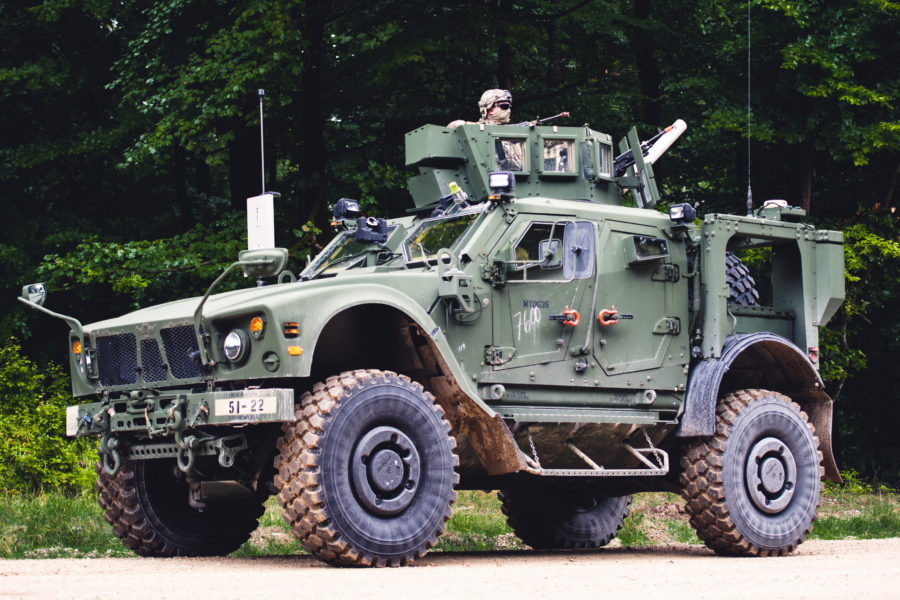The U.S. will provide another $625 million worth of military items to Ukraine, to include 200 Mine-Resistant Ambush-Protected vehicles, more HIMARS rocket launchers and nearly 200,000 rounds of artillery, mortars, and missiles, the Pentagon announced Oct 4.
The total value of arms provided by the U.S. to Ukraine since Russia’s February invasion is now $16.8 billion.
Laura K. Cooper, deputy assistant secretary of defense for Russia, Ukraine, and Eurasia, detailed a list of new items to include four HIMARS (High Mobility Artillery Rocket System) launchers and ammunition; 16 M777 Howitzers with more than 75,000 rounds of 155mm ammunition; 1,000 anti-armor missiles; and the 200 MRAPs, nearly doubling the number pledged or provided so far.
The MRAPS “provide Ukraine with a resilient capability for transporting troops in heavily mined terrain,” Cooper said at a Pentagon briefing. The vehicles were rapidly developed during the Afghanistan and Iraq wars to deal with the threat of improvised explosive devices; after those conflicts ended, many MRAPs were declared excess to U.S. military needs.
“This package will provide the Ukrainian Armed Forces with additional capabilities and munitions that it needs to maintain momentum in the East and in the South, including additional artillery and precision fires,” Cooper said.
“Ukraine has demonstrated the ability to use these capabilities to degrade Russian logistics and command-and-control, creating opportunities for Ukraine to maneuver and to advance. This has created, as [Defense Secretary Lloyd J. Austin III] said recently, a change in battlefield dynamics, even as the Russian government moves legislation today to claim parts of Ukrainian territory illegitimately.”
Cooper said Ukraine continues to “reclaim territory and to consolidate their gains.” The liberation of Lyman, accomplished in recent days, “was a significant operational accomplishment, and Ukrainian forces continue to make deliberate progress in the Kharkiv region, and also further south around Kherson,” she added.
The U.S. will continue to provide weaponry and equipment to Ukraine “to meet its urgent needs on the battlefield, while also building Ukraine’s enduring strength to defend its sovereignty over the long term,” Cooper said.
She also noted that Pentagon acquisition and sustainment chief William LaPlante participated in a meeting with 45 NATO and European Union armaments directors last week to make plans for the long-term provision of military aid to Ukraine during its fight against the Russian invasion.
While Congress has approved aid above and beyond what President Joe Biden has declared excess to U.S. needs and provided Ukraine, some members of Congress have raised the alarm that such transfers are cutting deeply into U.S. stocks. LaPlante said on Oct. 1 that NATO nations are making plans for sustained and “interchangeable” munitions production at a number of sites—likely to be in the U.S. and in Europe—to build weapons, but also to provide components critical for weapons.
LaPlante warned that the “long lead time” needed for components and materials means replacing weapons could be a lengthy process.
Cooper said the Pentagon is “looking very closely” at the rate at which Ukraine is consuming munitions and ammunition “to make sure that they have what they need for the counter-offensive and then the types of capabilities.”
The HIMARS have received a lot of attention “because you’ve seen how the Ukrainians can use these capabilities to take out critical Russian logistics nodes, command control nodes, ammunition depots, etc., and really weakened … the Russian forces’ ability to respond,” Cooper said. The additional HIMARS will give Ukrainian forces “flexibility in how they employ these capabilities…as they look for additional opportunities to seize the strategic advantage.”
A list of munitions and equipment provided to Ukraine since Russia’s invasion began in February, released by the Pentagon on Oct. 4, also noted 700 Phoenix Ghost tactical unmanned aerial systems; an unspecified number of aircraft-launched AGM-88 High-speed Anti-Radiation Missiles (HARMs); more than 8,500 Javelin anti-tank missiles, more than 1,400 Stinger shoulder-launched anti-aircraft missiles; “hundreds” of HumVee armored vehicles; eight NASAMS surface-to-air missile systems; electronic jamming equipment; cold weather gear and protective equipment for operating in a chemical/biological/radiological environment.
Cooper said the U.S. agrees that Ukraine need tanks, but stopped short of saying the U.S. would provide some of its M1 Abrams main battle tanks.
She also noted that the U.S. is not assisting Ukraine alone, but that many other nations are donating lethal and non-lethal aid, as well. Russia, by contrast, does not have such support, Cooper said.
“What is Russia doing? Russia is turning to North Korea for assistance. It’s turning to Iran. It doesn’t have that depth of support,” she said.


